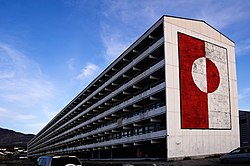Blok P
| Blok P | ||
|---|---|---|
 Blok P in Nuuk, with the largest Greenland flag on the facade |
||
| Data | ||
| place | Nuuk | |
| Architectural style | concrete | |
| Construction year | 1966 | |
| demolition | 2012 | |
| Coordinates | 64 ° 10 ′ 31.2 " N , 51 ° 44 ′ 1" W | |
|
|
||
Blok P was a residential building in Nuuk and the largest in Greenland . Until the demolition in 2012, the building's 320 apartments could accommodate around 1% of the entire Greenland population, at that time almost 57,000 inhabitants.
The building, a landmark of the Greenlandic capital for decades , was the symbol of the demographic concentration policy of the 1960s with the name G60 . This policy was aimed at the well-being of Scandinavian society based on a modern lifestyle. The project led to the migration of the population from the traditional settlements to the cities, where modern residential buildings were built based on multi-storey blocks 100 meters long. They consisted of prefabricated concrete elements and were offered as economical, efficient social living with modern comfort. However, Blok P later became a social hotspot until the city council decided on October 19, 2012 to demolish it.
construction
At the time of its construction, Blok P was the largest residential building in the entire Kingdom of Denmark and featured technological innovations notable for Greenland in the 1960s, such as doorbells and running water in the bathrooms. When the building was completed in 1966, the Danish newspaper Politiken wrote : "Now the Greenlanders live better than the Danes."
The inspiration was the style of Le Corbusier and the materials were the best of the time, with the idealistic starting point of a modern and functional construction that should provide an ideal environment for people with light and space.
However, the interior dimensions and the floor plan of the apartments proved to be unsuitable for the lifestyle of the Greenlanders. The doors and cloakrooms were too narrow for the heavy traditional Inuit winter clothing . Fishing gear placed on the balconies blocked the emergency exits. There were also problems with the drains, which were blocked by clotted blood from fish processing in the bathtub.
The north side of the building was decorated with the largest known Greenlandic flag. The flag, consisting of used clothes, was sewn by the Nuuk artist Julie Edel Hardenberg with the help of elementary school children.
demolition
Due to lack of maintenance, Blok P fell into disrepair over the years. The local population rejected the building, and tourists were introduced to it as "so depressing that it is almost an attraction in itself". In 2010, the Greenland Self-Government, together with the Nuuk City Council, proposed a plan to dismantle and renovate the building. The residents were offered other accommodation, mainly in the new Qinngorput district .
The five-stage demolition began in 2011; the last phase of the restructuring ended in 2014. During the demolition of the building, the visual artist Rikke Diemer made a documentary commemorating life in Blok P and installed a webcam to record the demolition day by day. She later organized an exhibition on Blok P with a group from the city at Nuuk's Katuaq Cultural Center . The film for Blok P was then shown in 2012 at the 13th Venice Architecture Biennale (2012) and at the Architecture + Design Film Festival. In July 2013, Nuuk City developed a new urban project called Nuuk Playground to meet the needs of the community.
Web links
- Film by Rikke Diemer about the demolition of Blok P on youtube.com, accessed on August 31, 2019
Individual evidence
- ↑ a b The dilemma of Blok P , at nordregio.se; accessed on August 31, 2019.
- ↑ Nuuk, Greenland, Blok P , at atlasobscura.com; accessed on August 31, 2019.
- ↑ Adam Grydehøj: Constructing a center on the periphery: urbanization and urban design in the city of Iceland Nuuk, Greenland. In: Island Studies Journal , 9.2, 2014, pp. 205–222.
- ↑ Blok P , at umage.nu; accessed on August 31, 2019.
- ^ Architecture + Design Film Festival (pp. 6-7) , at winnipegfilmgroup.com; accessed on August 31, 2019.
